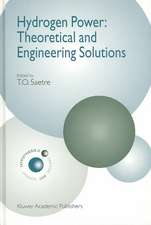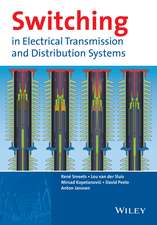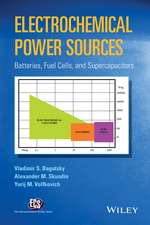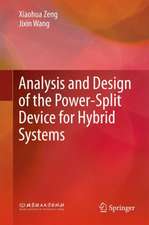Diffractive Optics for Thin-Film Silicon Solar Cells: Springer Theses
Autor Christian Stefano Schusteren Limba Engleză Hardback – 5 oct 2016
This thesis introduces a figure of merit for light trapping with photonic nanostructures and shows how different light trapping methods compare, irrespective of material, absorber thickness or type of nanostructure. It provides an overview of the essential aspects of light trapping, offering a solid basis for future designs.
Light trapping with photonic nanostructures is a powerful method of increasing the absorption in thin film solar cells. Many light trapping methods have been studied, but to date there has been no comprehensive figure of merit to compare these different methods quantitatively. This comparison allows us to establish important design rules for highly performing structures; one such rule is the structuring of the absorber layer from both sides, for which the authors introduce a novel and simple layer-transfer technique. A closely related issue is the question of plasmonic vs. dielectric nanostructures; the authors present an experimentaldemonstration, aided by a detailed theoretical assessment, highlighting the importance of considering the multipass nature of light trapping in a thin film, which is an essential effect that has been neglected in previous work and which allows us to quantify the parasitic losses.
| Toate formatele și edițiile | Preț | Express |
|---|---|---|
| Paperback (1) | 632.55 lei 6-8 săpt. | |
| Springer International Publishing – 15 iun 2018 | 632.55 lei 6-8 săpt. | |
| Hardback (1) | 638.76 lei 6-8 săpt. | |
| Springer International Publishing – 5 oct 2016 | 638.76 lei 6-8 săpt. |
Din seria Springer Theses
- 18%
 Preț: 997.88 lei
Preț: 997.88 lei -
 Preț: 389.88 lei
Preț: 389.88 lei - 15%
 Preț: 646.94 lei
Preț: 646.94 lei - 18%
 Preț: 943.43 lei
Preț: 943.43 lei -
 Preț: 399.29 lei
Preț: 399.29 lei - 18%
 Preț: 944.99 lei
Preț: 944.99 lei - 15%
 Preț: 636.80 lei
Preț: 636.80 lei - 18%
 Preț: 941.05 lei
Preț: 941.05 lei - 15%
 Preț: 643.16 lei
Preț: 643.16 lei - 15%
 Preț: 642.68 lei
Preț: 642.68 lei - 18%
 Preț: 1103.62 lei
Preț: 1103.62 lei - 20%
 Preț: 558.83 lei
Preț: 558.83 lei - 18%
 Preț: 1112.30 lei
Preț: 1112.30 lei - 18%
 Preț: 944.19 lei
Preț: 944.19 lei - 18%
 Preț: 1109.92 lei
Preț: 1109.92 lei - 18%
 Preț: 1217.27 lei
Preț: 1217.27 lei - 15%
 Preț: 640.06 lei
Preț: 640.06 lei - 15%
 Preț: 636.45 lei
Preț: 636.45 lei - 15%
 Preț: 640.06 lei
Preț: 640.06 lei - 15%
 Preț: 640.88 lei
Preț: 640.88 lei -
 Preț: 389.70 lei
Preț: 389.70 lei - 20%
 Preț: 563.91 lei
Preț: 563.91 lei -
 Preț: 393.35 lei
Preț: 393.35 lei - 15%
 Preț: 637.93 lei
Preț: 637.93 lei - 15%
 Preț: 641.85 lei
Preț: 641.85 lei - 18%
 Preț: 1225.94 lei
Preț: 1225.94 lei - 20%
 Preț: 551.36 lei
Preț: 551.36 lei - 18%
 Preț: 1229.10 lei
Preț: 1229.10 lei - 15%
 Preț: 639.25 lei
Preț: 639.25 lei - 18%
 Preț: 999.45 lei
Preț: 999.45 lei - 15%
 Preț: 640.06 lei
Preț: 640.06 lei - 18%
 Preț: 1220.45 lei
Preț: 1220.45 lei - 18%
 Preț: 1116.26 lei
Preț: 1116.26 lei - 18%
 Preț: 1110.72 lei
Preț: 1110.72 lei - 18%
 Preț: 1000.87 lei
Preț: 1000.87 lei - 18%
 Preț: 891.17 lei
Preț: 891.17 lei - 15%
 Preț: 640.06 lei
Preț: 640.06 lei - 5%
 Preț: 1154.07 lei
Preț: 1154.07 lei - 15%
 Preț: 635.96 lei
Preț: 635.96 lei - 15%
 Preț: 640.88 lei
Preț: 640.88 lei -
 Preț: 387.20 lei
Preț: 387.20 lei - 18%
 Preț: 1109.92 lei
Preț: 1109.92 lei -
 Preț: 385.25 lei
Preț: 385.25 lei -
 Preț: 385.25 lei
Preț: 385.25 lei - 18%
 Preț: 1112.30 lei
Preț: 1112.30 lei - 18%
 Preț: 999.45 lei
Preț: 999.45 lei -
 Preț: 386.99 lei
Preț: 386.99 lei - 15%
 Preț: 637.13 lei
Preț: 637.13 lei - 20%
 Preț: 554.21 lei
Preț: 554.21 lei - 20%
 Preț: 555.59 lei
Preț: 555.59 lei
Preț: 638.76 lei
Preț vechi: 751.47 lei
-15% Nou
Puncte Express: 958
Preț estimativ în valută:
122.22€ • 127.62$ • 100.93£
122.22€ • 127.62$ • 100.93£
Carte tipărită la comandă
Livrare economică 15-29 aprilie
Preluare comenzi: 021 569.72.76
Specificații
ISBN-13: 9783319442778
ISBN-10: 3319442775
Pagini: 171
Ilustrații: XX, 114 p. 56 illus., 11 illus. in color.
Dimensiuni: 155 x 235 x 10 mm
Greutate: 0.37 kg
Ediția:1st ed. 2017
Editura: Springer International Publishing
Colecția Springer
Seria Springer Theses
Locul publicării:Cham, Switzerland
ISBN-10: 3319442775
Pagini: 171
Ilustrații: XX, 114 p. 56 illus., 11 illus. in color.
Dimensiuni: 155 x 235 x 10 mm
Greutate: 0.37 kg
Ediția:1st ed. 2017
Editura: Springer International Publishing
Colecția Springer
Seria Springer Theses
Locul publicării:Cham, Switzerland
Cuprins
Introduction.- Nanostructures for Enhanced Light-Trapping in Thin-Film Silicon Solar Cells.- Fabrication and Characterisation of Diffractive Nanostructures.- Achievements.- Conclusions and Outlook.
Notă biografică
Christian Schuster started his studies in physics at Tuebingen (Germany), before continuing at Trento (Italy) with a BSc in nuclear physics. Due to the program being split between two universities, he received a German Diplom in nanotechnology and an Italian MSc in silicon electronics. Christian then moved to St Andrews (UK) to start his PhD project in silicon photonics as a Marie Curie Fellow; he finished this work at York, where he is still based.
Textul de pe ultima copertă
This thesis introduces a figure of merit for light trapping with photonic nanostructures and shows how different light trapping methods compare, irrespective of material, absorber thickness or type of nanostructure. It provides an overview of the essential aspects of light trapping, offering a solid basis for future designs.
Light trapping with photonic nanostructures is a powerful method of increasing the absorption in thin film solar cells. Many light trapping methods have been studied, but to date there has been no comprehensive figure of merit to compare these different methods quantitatively. This comparison allows us to establish important design rules for highly performing structures; one such rule is the structuring of the absorber layer from both sides, for which the authors introduce a novel and simple layer-transfer technique. A closely related issue is the question of plasmonic vs. dielectric nanostructures; the authors present an experimentaldemonstration, aided by a detailed theoretical assessment, highlighting the importance of considering the multipass nature of light trapping in a thin film, which is an essential effect that has been neglected in previous work and which allows us to quantify the parasitic losses.
Caracteristici
Nominated as an outstanding Ph.D. thesis by the University of York Elaborates the physical picture of Lambertian light trapping in detail Presents a material and thickness-independent figure of merit for light trapping Includes do-it-yourself instructions for setting up nanoimprint and absorption measurement tools Includes supplementary material: sn.pub/extras











